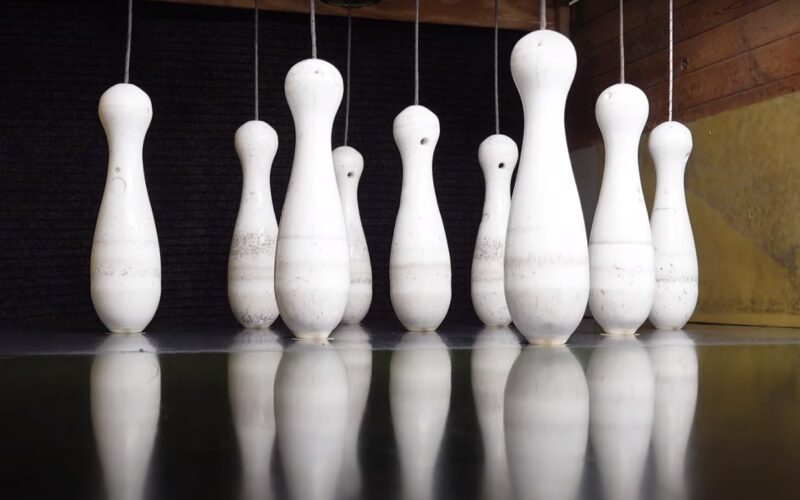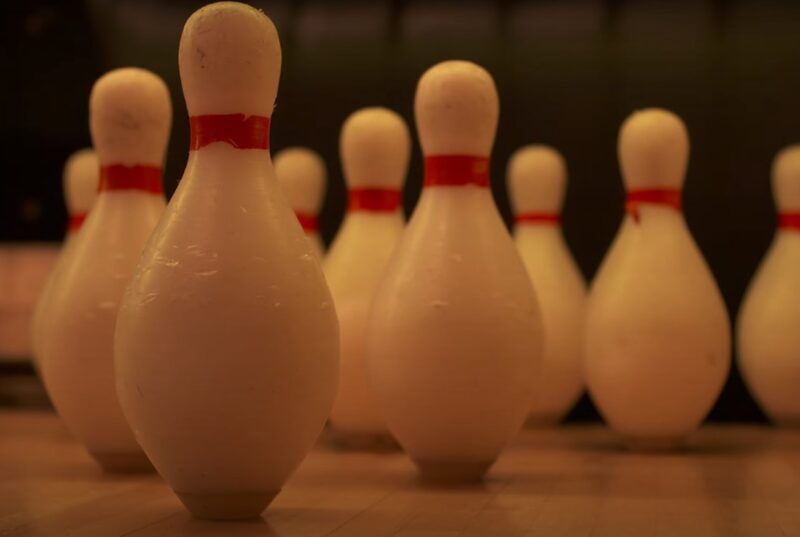Did you know that bowling is one of the oldest sports in the world? Archaeologists have found evidence of bowling-like games dating back to ancient Egypt, Rome, and Greece.
Today, bowling is enjoyed by millions of people around the world, who play different versions of the game with different rules and equipment. In this article, we will explore how many pins are used in various forms of bowling and why.
We will look at the most common types of bowling, such as ten-pin, nine-pin, and five-pin, as well as some less common ones, such as candlepin and duckpin. We will also learn about the history, characteristics, and challenges of each type of bowling, and how they differ from each other.
By the end of this article, you will have a better understanding of the sport of bowling and its diversity.
Ten-Pin Bowling

Widely played in over 90 countries, ten-pin bowling stands as the most popular form of the sport. Players aim to topple ten pins, set up in a triangular pattern at the lane’s end.
Each pin, standing at 15 inches and weighing around 3 pounds, features a distinctive red stripe and a numbered white body. Bowlers use a ball, typically weighing between 6 and 16 pounds, equipped with three holes for fingers.
In each of the game’s ten frames, players have two opportunities to knock down all the pins.
Scoring and Techniques
Scoring in ten-pin bowling hinges on the number of pins felled and the shot types. A ‘spare’ occurs when all pins are hit in two tries, while a ‘strike’ is achieved by knocking all pins down in a single shot.
Spares add 10 points plus the pins from the next shot; strikes gain 10 points plus the pins from the next two shots. A perfect game score, consisting of 12 consecutive strikes, is 300 points.
For more bowling expressions move to this article.
Challenges and Skills
This sport demands precision, strategy, and skill. Players must avoid fouls, which occur when crossing the foul line or touching the lane. They also face ‘splits’ – challenging pin arrangements left after the first shot – and the dreaded ‘gutter ball‘, where the ball misses the pins entirely.
Mastery involves adjusting the ball’s speed, angle, and spin, essential for overcoming these hurdles and maximizing the score.
Nine-Pin Bowling

Nine-pin bowling, predominantly played in Europe and Latin America, ranks as the second most popular bowling variant. Players aim to knock down nine pins, set in a diamond pattern with a distinctive red pin at the center.
These pins are somewhat smaller and lighter compared to ten-pin bowling pins. Players use a ball weighing between 8 and 10 pounds, notably lacking finger holes.
Each game consists of six rounds, with players getting two attempts per frame. Scoring in nine-pin bowling depends on both the number of pins toppled and the specific position of the red pin.
Regular pins count for one point each, while the red pin scores nine points if it’s the last standing, or 12 if it falls with others. Achieving a perfect score of 180 requires knocking down all pins in each frame.
Teamwork Triumphs
Nine-pin bowling is inherently a team sport, accommodating up to six players per team, with the team’s total score being the aggregate of individual scores. This form of bowling blends fun, social interaction, teamwork, and a bit of luck.
The key to success is targeting the red pin, a crucial score influencer.
Beyond the Basics
Players must adapt to varying lane conditions, including oil patterns and wood surfaces. Distinguishing features from ten-pin bowling include the smaller, lighter ball without finger holes, a longer and narrower lane without gutters, and more cylindrical pins.
These differences demand unique strategies and skills, making nine-pin bowling a distinct and engaging variant of the sport.
Five-Pin Bowling
Ranking as the third most popular type, five-pin bowling holds a special place in Canadian culture. This game involves knocking down five pins arranged in a V-formation at the lane’s end.
Gameplay and Scoring
Each pin carries a different point value based on its position. The central pin is worth five points, the adjacent ones are three points each, and the outer pins are two points each.
Players use a small, 3-4 pound ball, designed to fit in the hand without finger holes and get three attempts per frame in each of the game’s ten rounds. Scoring in five-pin bowling shares similarities with ten-pin but includes unique variations.
Striking all pins in one shot earns 15 points plus the next two shots’ scores. A spare, clearing all pins in two shots, also scores 15 points plus the next shot’s score.
The perfect game score is 450, achieved with 12 consecutive strikes.
Challenges and Strategy
Five-pin bowling demands precision and strategic play. The primary target is the valuable but challenging center pin.
Players must consider the ball’s angle and speed, along with lane conditions like oil patterns and wood quality.
Distinctive Features
This variant differs in several aspects from other forms of bowling. Players have three balls per frame, unlike the two in ten-pin and nine-pin or one in candlepin and duckpin bowling.
The maximum score of 450 is higher than in nine-pin (180), candlepin (300), and duckpin (300) bowling. The challenge level is elevated due to smaller pins and a more complex scoring system, making five-pin bowling a uniquely demanding and engaging sport.
Candlepin Bowling

Originating in New England and popular in Eastern Canada, candlepin bowling is a unique ten-pin variant. Characterized by long, slender pins resembling candles, this style offers a distinct challenge.
Players use a small, lightweight ball, comparable in size to a grapefruit, and are allowed three throws per frame.
Dynamic Gameplay
In candlepin bowling, pins knocked down during a frame aren’t cleared away until the frame concludes. This rule adds a strategic element, as downed pins can become either obstacles or aids in striking the remaining pins.
Duckpin Bowling: Eastern U.S. Favorite

Duckpin bowling, primarily played in the Eastern United States, also utilizes ten pins. However, these pins are short and squat, akin to ducks.
The ball in duckpin bowling, slightly larger than its candlepin counterpart, lacks finger holes and can be thrown three times per frame. Unlike candlepin, the pins are reset after each throw.
Challenges and Skill
Both candlepin and duckpin bowling are renowned for their difficulty, demanding greater precision and finesse compared to traditional ten-pin bowling. Due to the unique pin shapes and sizes, achieving strikes and spares is less common, resulting in generally lower scoring averages in these versions.
These variations offer bowlers a challenging and nuanced experience, distinct from the standard game.
FAQ
What is the origin of ten-pin bowling?
Ten-pin bowling evolved from ancient games but took its modern form in the United States. It became standardized in the late 19th century with the establishment of rules and equipment specifications.
Why are candlepin bowling pins shaped differently?
Candlepin bowling pins are slender and cylindrical to make the game more challenging. Their unique shape affects how they fall and interact with the ball, requiring different strategies compared to traditional bowling.
Can children play these types of bowling easily?

Yes, children can play various forms of bowling. Many alleys offer lightweight balls and bumper lanes for kids. Five-pin bowling, with smaller balls and fewer pins, is particularly child-friendly.
Is duckpin bowling easier than ten-pin bowling?
Duckpin bowling is often considered more challenging than ten-pin due to the smaller balls and pins, making strikes and spares harder to achieve.
How does the scoring in candlepin bowling differ from ten-pin?
In candlepin bowling, players get three throws per frame, and pins are not cleared away between throws. Scoring is similar to ten-pin, but the presence of downed pins adds a strategic element.
Are there professional leagues for these bowling types?
Yes, there are professional leagues and tournaments for different bowling types, especially for ten-pin and candlepin bowling, with varying levels of popularity and coverage.
Final Words
Bowling, a sport with ancient roots, has evolved into various forms enjoyed worldwide. This article delved into the different types of bowling, focusing on the number of pins used in each variant.
From the widely played ten-pin bowling, with its standard triangular arrangement of ten pins, to the European and Latin American favorite, nine-pin bowling, featuring a diamond formation with a central red pin, each style has its unique characteristics and challenges. We also explored five-pin bowling, a Canadian favorite, where each pin has a different point value, and other less common types like candlepin and duckpin bowling, each with their distinct pin shapes and playing strategies.
This exploration not only highlighted the diversity of bowling but also its rich history and the various skills required for each type. Whether it’s the strategic placement of pins, the weight and design of the balls, or the scoring systems, bowling offers a wide range of experiences, making it a fascinating and enduring sport.
